Hodbarrow
Millom, Cumbria
|

Featured Location Guide |
Hodbarrow was a quiet stretch of beach with a
disused windmill, a couple of lime kilns and a farm in 1855 and the town of
Millom did not exist (Millom was the name of a district between the rivers
Duddon & Esk, where the lords of Millom at Millom Castle, held jura
regalia, the right to execute without
trial, and not even the
sheriff of Cumberland could enter without their say) and the area had
a population of less than 100 inhabitants. The same area by 1891 had a
population of over 10,500, due in 1855 to the discovery of haematite iron
ore and over the years Hodbarrow took the shape we see today.
| The main features left for modern eyes
to see are two lighthouses, one of stone, which was built in 1866 and
was paraffin fuelled and the other built of steel in 1905 to replace the
earlier was electric. The two sea walls are unmistakeable, the Old Sea
Wall of concrete was completed in 1890 and stands 50' from top to
bottom. The Old Sea Wall only stood for ten years before subsidence took
its centre section, but it still remains an impressive Victorian
industrial edifice to this day. The Old Sea Wall was replaced with the
Outer Barrier, at over a mile long and completed in 1905, it was built
to subside with the land, which it has done for over a century, and
apart from the fact that the seaward blocks are now out of their
symmetrical alignment, you would never notice. The Outer Barrier
reclaimed over 200 acres of beach and tidal estuary.
Hodbarrow Windmill stands high above
Hodbarrow Point and looks the same today as it did in photographs taken
of the first pit heads near by in the late 1850's, it is often mistaken
as a third lighthouse. When the pumps were finally turned off in 1968
the area behind the Outer Barrier began to fill with water and now a 200
acre lagoon exists, which is rich in wildlife.
At its peak Hodbarrow Mines employed
over 1000 people, had 40 miles of railway and tram lines and many pit
heads and their associated buildings, including Cornish pump houses.
Sadly, all was demolished or ripped up in 1968-9, but one can still see
where some of these things were if you look carefully.
Hodbarrow also has a quality water
sports centre, with skiing and wake boarding for sports minded
photographers to partake of. |
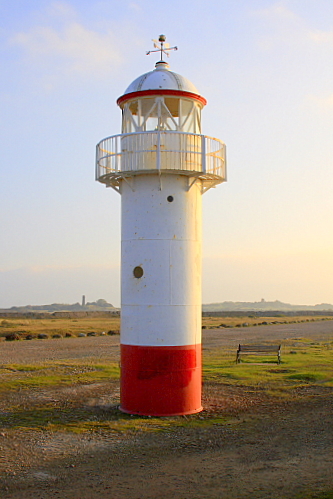
Outer Barrier
Lighthouse by Trevor Kirk |
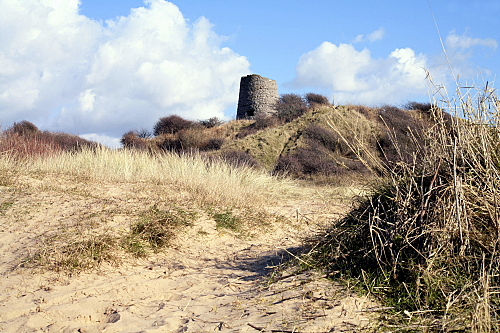
Hodbarrow Windmill by Trevor Kirk
Wildlife and Nature Highlights
Birds are the main attraction, but mammals are
about too. Hodbarrow during winter is home to between 5,000-10,000 wildfowl,
including:- Teal, Widgeon, Red-Breasted Merganser, Coot, Mallard, Tufted
Duck, Pochard, Golden Eye, with the possibility of Long-Tailed Duck, Eider,
Scaup, grebes & diver spp, as well as, swans, & geese. Passage migrants
visit in spring and autumn, including some rarities. Spring and summer are
the times to see Great Crested Grebes displaying. A number of tern spp. nest
on the site, including Little Tern some years. Peregrine Falcon, Kestrel and
Sparrowhawk are present throughout the year, and Merlin are usually seen in
winter. Barn Owl can be seen quartering fields adjacent to Hodbarrow, but is
not as common as 20 years ago, sadly. Passerines are abundant in the scrub
areas and even along the Outer Barrier. Wading birds are also abundant, and
rare birds often appear among the flocks of Dunlin and Redshank, which roost
on the site. Waders are best seen between an hour before and an hour after
high tide, as they come into roost on Hodbarrow.
One of Hodbarrow's big attractions is the
Natterjack Toad, but as this is a highly protected species, I would suggest
contacting the RSPB before photographing them: certainly do not disturb
them.
Smaller mammal species, including fox are
present at Hodbarrow, but are not as visual as the bird life.
Among the plants to look out for are Marsh &
Bee Orchid.
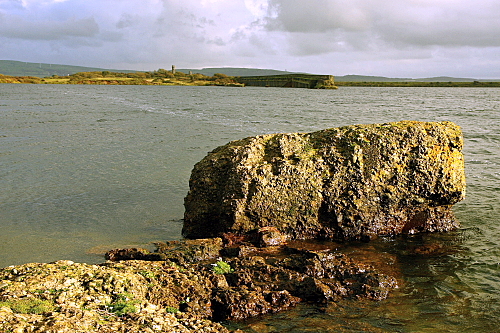 |
Apart from the industrial
heritage and wildlife, Hodbarrow is surrounded by the Duddon Estuary and
Black Combe fell at 1970' is a stunning backdrop, with the Coniston and
Scafell ranges in the distance and the Furness fells just across the
Duddon; therefore landscapes and seascapes are a plenty. The West
Cumbrian coast also has some of the best sunsets of anywhere in the
world.
Remains of the Old Sea Wall at the
now flooded former Haematite Mines, looking across Hodbarrow Lagoon
Trevor Kirk |
Hodbarrow is a place to visit at any time of
the year, but always where stout footwear. In winter, take warm and wind
proof clothing as the Outer Barrier can be a bitterly cold place. Summer
brings its own perils with the sun (Millom has similar temperatures to
southern Cornwall), and Terns, which will attack if they feel threatened: a
tripod is very useful for defence if extended and carried over the shoulder
and above the head.
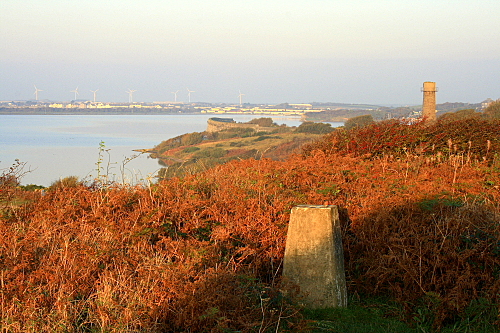
View from Trig Point by Trevor Kirk
|
Other nearby areas of photographic
opportunities
Depending on the
subject sought, the Millom area offers a vast array of things to
photograph.
-
Swinside Stone Circle is 4 miles from
Hodbarrow.
-
Giant's Grave standing stones at
Kirksanton are 3 miles.
-
Haverigg beach & dunes are 1 mile.
-
Silecroft beach is 4 miles.
-
Black Combe is 4 miles, from the summit
can be seen unsurpassed views of the lake district and on a clear day
Scotland, Isle of Man, & Wales can be seen, On a clear winter's night
Ireland can be seen too.
-
There are some good waterfalls on the
Whitbeck side of Black Combe – 5 miles.
-
The Duddon Valley is well worth a visit
to see the valley Wordsworth loved – 8 miles to Duddon Bridge.
-
For more wildlife try the Duddon Estuary
from Millom Iron Works Nature Reserve
-
Millom Pier – 1.5 miles.
Image: View to Black Combe across
Hodbarrow Lagoon
Trevor Kirk |
 |
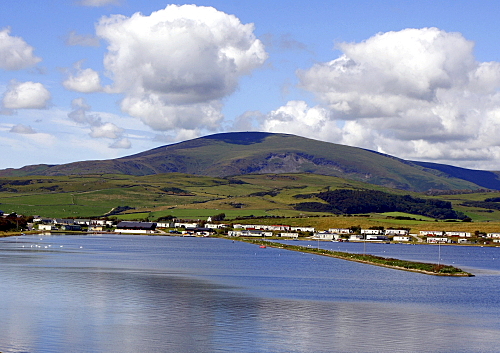
Blackcombe by Trevor Kirk
| Further information Grid
|
Location: |
Hodbarrow, Millom,
Cumbria |
|
Ceremonial County: |
Cumberland |
|
Grid Reference: |
SD183781 and SD174790 |
|
Map Link: |
Multimap
 |
|
Aerial photo: |
Multimap Aerial
 Googel Aerial
Googel Aerial
 |
|
Route(s):
|
|
|
Best Times to Visit: |
Any time of year or day, depending on subjects
sought |
|
E-mail: |
Campfield.marsh@rspb.org.uk |
|
Website: |
RSPB
 |
|
Other useful
websites: |
Hoseasons Caravan Park
 |
|
Nearby Locations: |
Swinside Stone Circle. Millom Pier
Millom Pier
Giant's Grave standing stones at Kirksanton
Millom Iron Works Nature Reserve. |
|
Other Relevant pages: |
|
|
|
.
Planning Grid
|
Location: |
Hodbarrow, Millom, Cumbria |
|
Grid Reference: |
SD183781 and SD174790 |
|
Getting there: |
Follow A5093 to Millom. Cross railway bridge
to town centre and take second on the right, look for Hodbarrow RSPB brown
sign and turn into Mainsgate Road (postcode LA18 4JZ). Go past the CPG
factory and continue to the very end of Mainsgate Road, here turn left.
Drive past the entrance to the amenity refuse site and park near the RSPB
sign. Alternatively, turn right at the bottom of Mainsgate road, drive
through the caravan park, and as you leave the caravan park, you can park on
the left overlooking the foreshore, near to the Outer Barrier. The site can
be driven round in its entirety, but some of the tracks are very badly pot
holed in places.
Millom railway station is about 1.5 mile from
Hodbarrow
NB:- no Sunday service. |
|
Access: |
RSPB Nature Reserve. Open access at all times.
Port Haverigg caravan park. Public right of
way runs through the site, but please do not wander through the areas marked
private, as many of the mobile homes are permanently occupied. |
|
Parking: |
Car parking is available at
the above mentioned places, but you can park in any suitable place, as long
as it does not cause a nuisance to other people or the wildlife. |
|
Facilities: |
There is a public hide near the Outer Barrier
Lighthouse. Nearest public conveniences are at Millom Pleasure Ground, or
Haverigg Sea front, and also at the council car park adjacent to Somerfield
supermarket. Food is available in summer at the beach cafe at Haverigg and
at local pubs in Haverigg & Millom. |
|
Things To Do,
See and Photograph: |
two lighthouses, Hodbarrow Windmill, Old Sea
Wall, 200 acre lagoon, rich in wildlife, water sports centre, with skiing
and wake boarding |
|
What to take: |
Always where stout footwear. Winter - take
warm and wind proof clothing especially at the Outer Barrier.
For wildlife take a tripod, and a long lens
(300mm plus) and a small lightweight stool for use when not near the hide.
For water sports a long lens is useful, but
not essential.
For landscapes a tripod, filters, and a bubble
level are helpful.
Macro work can be very rewarding, so pack a
macro lens or extension tubes if macro is your thing. |
|
Nature highlights: |
During winter between 5,000 - 10,000 wildfowl,
including:- Teal, Widgeon, Red-Breasted Merganser, Coot, Mallard, Tufted
Duck, Pochard, Golden Eye, with the possibility of Long-Tailed Duck, Eider,
Scaup, grebes & diver spp, as well as, swans, & geese. Spring and summer
Great Crested Grebes displaying. Wading birds. best seen between an hour
before and an hour after high tide, are also abundant, and rare birds often
appear among the flocks of Dunlin and Redshank.
Natterjack Toad, but as this is a highly
protected species.
Among the plants to look out for are Marsh &
Bee Orchid. |
|
Address: |
Port Haverigg Holiday Park
Haverigg
MILLOM
Cumbria |
|
Postcode: |
LA18 4EL |
|
Telephone: |
01697 351330 RSPB Warden – Campfield Marsh. |
|
Opening times: |
Open at all times |
|
Charges: |
None |
|
Photo Restrictions: |
RSPB site. None – except at or near the nest
site.
Caravan Park. None, but be aware many of
the caravans are private homes. |
|
Other Restrictions: |
Please do not enter any area where it will
disturb the wildlife, especially the area of slag where the terns, etc.,
nest: Use the hide for observing this area. Do not take vehicles, etc., off
the tracks, as there are rare plants located over the site. |
|
Special Needs Access: |
None. Though most of the site is accessible by
vehicle. The network of pathways around the grassland and scrub is not
suitable for wheelchair access and some pathways are blocked to prevent
unauthorised access by quad-bikes and motorbikes. People with some ambulant
difficulties would be able to use these, as they are generally firm and dry.
This is a natural site with unimproved paths and trails - the access
around this site may not be suitable for all visitors. |
|
Special Needs Facilities: |
None |
|
Children Facilities: |
None specific |
|
Dogs Allowed: |
RSPB land - allowed, in the caravan park need
to be kept on lead |
|

|
Please let us know any other information that we
can add to the Further information and Planning Grids or page and any errors that you discover. Before making a long trip to any location it is always
wise to double check the current information, websites like magazines may be
correct at the time the information is written, but things change and it is of
course impossible to double check all entries on a regular basis. If you have
any good photographs that you feel would improve the illustration of this page
then please let us have copies. In referring to this page it is helpful if you
quote both the Page Ref and Classification from the Grids above. To print the
planning grid select it then right click and print the selected area.
Please submit information on locations you discover so
that this system continues to grow.
|